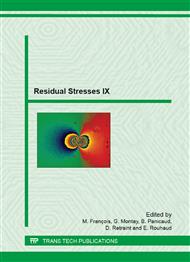[1]
R.A. Patterson, Fundamentals of Explosion Welding, in: D. L. Olson, T. A. Siewert, S. Liu, G. R. Edwards (Eds. ), ASM Handbook: Volume 6: Welding Brazing and Soldering, ASM International, Ohio, (1993).
DOI: 10.31399/asm.hb.v06.a0001351
Google Scholar
[2]
A.S. Bahrani, T.J. Black, B. Crossland, The mechanics of wave formation in explosion welding, P. Roy. Soc. Lond. A Mat. 296, 1967, 224-239.
Google Scholar
[3]
S.A.A. Akbari-Mousavi, L.M. Barrett, S.T.S. Al-Hassani, Explosion welding of metal plates, J. Mater. Process. Tech. 202 (2008) 224-239.
DOI: 10.1016/j.jmatprotec.2007.09.028
Google Scholar
[4]
F. Findik, Recent developments in explosion welding, Mater. Design 32 (2011) 1081-1093.
Google Scholar
[5]
M. Acarer, B. Gülenç, F. Findik, Investigation of explosion welding parameters and their effects on microhardness and shear strength, Mater. Design 24 (2005) 659-664.
DOI: 10.1016/s0261-3069(03)00066-9
Google Scholar
[6]
A. R. Pyzalla, Internal Stresses in Engineering Materials, in: W. Reimers, A. R. Pyzalla, A. Schreyer, H. Clemens (Eds. ), Neutrons and Synchrotron Radiation in Engineering Materials Science, Wiley-VCH., Weinheim, 2008, pp.21-56.
DOI: 10.1002/9783527621927.ch2
Google Scholar
[7]
M.E. Fitzpatrick, M.T. Hutchings, P.J. Withers, Separation of macroscopic, elastic mismatch and thermal expansion misfit stresses in metal matrix composite quenched plates from neutron diffraction measurements, Acta Mater. 45 (1997) 4867-4676.
DOI: 10.1016/s1359-6454(97)00209-7
Google Scholar
[8]
E. P. Pokataev, Y. P. Trykov, A. S. Kraev, Calculations and experimental determination of residual deflections of bimetallic components produced by explosion welding, Weld. Int. 13 (1999) 482-484.
DOI: 10.1080/09507119909447400
Google Scholar
[9]
W. Yasheng, C. Hongneng, M. Ninxu, Measurement of residual stresses in a multi-layer explosion welded joint with successive milling technique, Strain 35 (2008) 7-10.
DOI: 10.1111/j.1475-1305.1999.tb01112.x
Google Scholar
[10]
M. Sedighi, M. Honarpisheh, Experimental study of through-depth residual stress in explosion welded Al-Cu-Al multilayer, Mater. Design 37 (2012) 577-581.
DOI: 10.1016/j.matdes.2011.10.022
Google Scholar
[11]
A. Karolczuk, K. Kluger, M. Kowalski, F. Zok, G. Robak, Residual stresses in steel-titanium composite manufactured by explosive welding, Mat. Sci. Forum 726 (2012) 125-132.
DOI: 10.4028/www.scientific.net/msf.726.125
Google Scholar
[12]
Y. Taran, A. M. Balagurov, B. Sabirov, V. Davydov, A. M. Venter, Neutron diffraction investigation of residual stresses induced in niobium-steel bilayer pipe manufactured by explosive welding, Mat. Sci. Forum 768-769 (2014) 697-704.
DOI: 10.4028/www.scientific.net/msf.768-769.697
Google Scholar
[13]
B. Mateša, D. Kozak, A. Stoić, I. Samardžić, The influence of heat treatment by annealing on clad plates residual stresses, Metalurgjia, 50 (2011) 227-230.
Google Scholar
[14]
M. Honarpisheh, M. Asemabadi, M. Sedighi, Investigation of annealing treatment on the interfacial properties of explosive-welded Al/Cu/Al multilayer, Mater. Design 37 (2012) 122-127.
DOI: 10.1016/j.matdes.2011.12.045
Google Scholar
[15]
F. Findik, R. Yilmaz, T. Somyurek, The effects of heat treatment on the microstructure and microhardness of explosive welding, Sci. Res. Essays 6 (2011) 4141-4151.
DOI: 10.5897/sre11.1018
Google Scholar
[16]
R. Kaçar, M. Acarer, An investigation on explosion cladding of 316L stainless steel-din-P355GH steel, J. Mater. Process. Tech. 152 (2004) 91-96.
DOI: 10.1016/j.jmatprotec.2004.03.012
Google Scholar
[17]
Y. Kaya, N. Kahraman, An investigation into explosion welding/cladding of Grade A ship steel/AISI 316L austenitic stainless steel, Mater. Design 52 (2013) 367-372.
DOI: 10.1016/j.matdes.2013.05.033
Google Scholar
[18]
J.W. Elmer, D.L. Olson, D.K. Matlock, The Thermal Expansion Characteristics of Stainless Steel Weld Metal, Weld. Res. Supp. 61 (1982) 293-301.
Google Scholar


